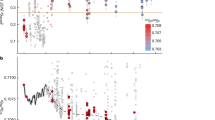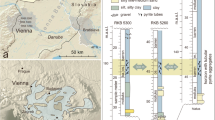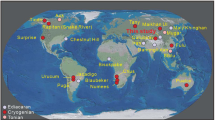Abstract
Progressive oxygenation of the Earth's early biosphere is thought to have resulted in increased sulphide oxidation during continental weathering, leading to a corresponding increase in marine sulphate concentration1. Accurate reconstruction of marine sulphate reservoir size is therefore important for interpreting the oxygenation history of early Earth environments. Few data, however, specifically constrain how sulphate concentrations may have changed during the Proterozoic era (2.5–0.54 Gyr ago). Prior to 2.2 Gyr ago, when oxygen began to accumulate in the Earth's atmosphere2,3, sulphate concentrations are inferred to have been <1 mM and possibly <200 µM, on the basis of limited isotopic variability preserved in sedimentary sulphides4 and experimental data showing suppressed isotopic fractionation at extremely low sulphate concentrations1,5. By 0.8 Gyr ago, oxygen and thus sulphate levels may have risen significantly6,7. Here we report large stratigraphic variations in the sulphur isotope composition of marine carbonate-associated sulphate, and use a rate-dependent model for sulphur isotope change that allows us to track changes in marine sulphate concentrations throughout the Proterozoic. Our calculations indicate sulphate levels between 1.5 and 4.5 mM, or 5–15 per cent of modern values, for more than 1 Gyr after initial oxygenation of the Earth's biosphere. Persistence of low oceanic sulphate demonstrates the protracted nature of Earth's oxygenation. It links biospheric evolution to temporal patterns in the depositional behaviour of marine iron- and sulphur-bearing minerals4, biological cycling of redox-sensitive elements6 and availability of trace metals essential to eukaryotic development8.
This is a preview of subscription content, access via your institution
Access options
Subscribe to this journal
Receive 51 print issues and online access
$199.00 per year
only $3.90 per issue
Buy this article
- Purchase on Springer Link
- Instant access to full article PDF
Prices may be subject to local taxes which are calculated during checkout



Similar content being viewed by others
References
Canfield, D. E., Habicht, K. S. & Thamdrup, B. The Archean sulfur cycle and the early history of atmospheric oxygen. Science 288, 658–661 (2000)
Farquhar, J., Bao, H. & Thiemens, M. Atmospheric influences of the Earth's earliest sulfur cycle. Science 289, 756–758 (2000)
Karhu, J. A. & Holland, H. D. Carbon isotopes and the rise in atmospheric oxygen. Geology 24, 867–870 (1996)
Canfield, D. E. A new model for Proterozoic ocean chemistry. Nature 396, 450–453 (1998)
Habicht, K. S., Gade, M., Thamdrup, B., Berg, P. & Canfield, D. E. Calibration of sulfate levels in the Archean ocean. Science 298, 2372–2375 (2002)
Canfield, D. E. & Teske, A. Late Proterozoic rise in atmospheric oxygen concentration inferred from phylogenetic and sulphur-isotope studies. Nature 382, 127–132 (1996)
Habicht, K. S. & Canfield, D. E. Isotope fractionation by sulfate-reducing natural populations and the isotopic composition of sulfide in marine sediments. Geology 29, 555–558 (2001)
Anbar, A. D. & Knoll, A. H. Proterozoic ocean chemistry and evolution: a bioinorganic bridge? Science 297, 1137–1142 (2002)
Kump, L. R. & Arthur, M. A. Interpreting carbon-isotope excursions; carbonates and organic matter. Chem. Geol. 161, 181–198 (1999)
Staudt, W. J. & Schoonen, M. A. A. Sulfate incorporation into sedimentary carbonates. Am. Chem. Soc. Symp. 612, 332–345 (1995)
Burdett, J. W., Arthur, M. A. & Richardson, M. A Neogene seawater sulfur isotope age curve from calcareous pelagic microfossils. Earth Planet. Sci. Lett. 94, 189–198 (1989)
Lyons, T. W., Luepke, J. J., Schreiber, M. E. & Zeig, G. A. Sulfur geochemical constraints on Mesoproterozoic restricted marine deposition: Lower Belt Supergroup, northwestern United States. Geochim. Cosmochim. Acta 64, 427–437 (2000)
Strauss, H. The isotopic composition of sedimentary sulfur through time. Palaeogeogr. Palaeoclimatol. Palaeoecol. 132, 97–118 (1997)
Paytan, A., Kastner, M., Campbell, D. & Thiemans, M. H. Sulfur isotopic composition of Cenozoic seawater sulfate. Science 282, 1459–1462 (1998)
Kampschulte, A., Bruckschen, P. & Strauss, H. The sulphur isotopic composition of trace sulphates in Carboniferous brachiopods: implications for coeval seawater, correlation with other geochemical cycles and isotope stratigraphy. Chem. Geol. 175, 149–173 (2001)
Hurtgen, M. T., Arthur, M. A., Suits, N. & Kaufman, A. J. The sulfur isotopic composition of Neoproterozoic seawater sulfate: implications for a snowball Earth? Earth Planet. Sci. Lett. 203, 413–429 (2002)
Luepke, J. J. & Lyons, T. W. Pre-Rodinian (Mesoproterozoic) supercontinental rifting along the western margin of Laurentia: geochemical evidence from the Belt-Purcess Supergroup. Precambr. Res. 111, 79–90 (2001)
Whelan, J. F., Rye, R. O., deLorraine, W. & Ohmoto, H. Isotopic geochemistry of a mid-Proterozoic evaporite basin: Balmat, New York. Am. J. Sci. 290, 396–424 (1990)
Gellatly, A. M. & Lyons, T. W. Trace sulfate in Mid-Proterozoic carbonates and the sulfur isotope record. Geochim. Cosmochim. Acta (in the press)
Azmy, K. et al. Dolomitization and isotope stratigraphy of the Vazante Formation, São Francisco Basin, Brazil. Precambr. Res. 112, 303–329 (2001)
Kah, L. C., Lyons, T. W. & Chesley, J. T. Geochemistry of a 1.2 Ga carbonate-evaporite succession, northern Baffin and Bylot Islands: implications for Mesoproterozoic marine evolution. Precambr. Res. 111, 203–234 (2001)
Frank, T. D., Kah, L. C. & Lyons, T. W. Changes in organic matter production and accumulation as a mechanism for isotopic evolution in the Mesoproterozoic ocean. Geol. Mag. 140, 373–396 (2003)
Bosscher, H. & Schlager, W. Accumulation rates of carbonate platforms. J. Geol. 101, 345–355 (1993)
Shen, Y., Knoll, A. H. & Walter, M. R. Evidence for low sulphate and anoxia in a mid-Proterozoic marine basin. Nature 423, 632–635 (2003)
Shen, Y., Canfield, D. E. & Knoll, A. H. Middle Proterozoic ocean chemistry: Evidence from the McArthur Basin, northern Australia. Am. J. Sci. 302, 81–109 (2002)
Brennan, S. T., Lowenstein, T. K. & Horita, J. Seawater chemistry and the advent of biocalcification. Geology 32, 473–476 (2004)
Knoll, A. H., Hayes, J. M., Kaufman, A. J., Swett, K. & Lambert, I. B. Secular variation in carbon isotope ratios from Upper Proterozoic successions of Svalbard and East Greenland. Nature 321, 832–838 (1986)
Grotzinger, J. P. Facies and evolution of Precambrian depositional systems: emergence of the modern platform archetype. SEPM Spec. Publ. 44, 79–106 (1989)
Berner, R. A. Modeling atmospheric O2 over Phanerozoic time. Geochim. Cosmochim. Acta 65, 685–694 (2001)
Schlesinger, W. H. Biogeochemistry (Academic, San Diego, 1997)
Acknowledgements
This work was supported by the NSF, the National Geographic Society, the Polar Continental Shelf Project (Natural Resources, Canada), and the University of Missouri Research Board.
Author information
Authors and Affiliations
Corresponding author
Ethics declarations
Competing interests
The authors declare that they have no competing financial interests.
Supplementary information
Supplementary Methods
Provides a detailed description of procedures for extraction of CAS from carbonate rocks for isotopic analysis, as well as the analytical procedures used in isotopic determinations. (DOC 21 kb)
Supplementary Data
Provides tables of CAS data that, at the time of manuscript writing, were not otherwise available in a peer-reviewed publication format. This includes CAS data from the Society Cliffs Formation and Dismal Lakes Groups (this study), as well as used data from Gellatly and Gellatly & Lyons (M.S. thesis, currently accepted for publication in Geochimica et Cosmochimica Acta). (DOC 30 kb)
Supplementary Figures
Provides graphical representation of model sensitivities to total fractionation (ΔS), weathering rate (Fw) and deposition/accumulation rate (δS/dt) parameters. (DOC 96 kb)
Rights and permissions
About this article
Cite this article
Kah, L., Lyons, T. & Frank, T. Low marine sulphate and protracted oxygenation of the Proterozoic biosphere. Nature 431, 834–838 (2004). https://doi.org/10.1038/nature02974
Received:
Accepted:
Issue Date:
DOI: https://doi.org/10.1038/nature02974
This article is cited by
-
Oxygenation of the Earth aided by mineral–organic carbon preservation
Nature Geoscience (2023)
-
Late acquisition of the rTCA carbon fixation pathway by Chlorobi
Nature Ecology & Evolution (2023)
-
The Black Angel deposit, Greenland: a Paleoproterozoic evaporite-related Mississippi Valley-type Zn–Pb deposit
Mineralium Deposita (2023)
-
Reconstructing Earth’s atmospheric oxygenation history using machine learning
Nature Communications (2022)
-
A persistently low level of atmospheric oxygen in Earth’s middle age
Nature Communications (2021)
Comments
By submitting a comment you agree to abide by our Terms and Community Guidelines. If you find something abusive or that does not comply with our terms or guidelines please flag it as inappropriate.



